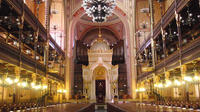A Journey through Jewish Budapest 3 Hour Private Excursion with a Historian
Budapest, Hungary
Trip Type: Private Tours
Duration: 3 hours
With the help of a historian, this 3 hour walking tour allows you to grasp the dynamic experience of what Jewish culture and everyday life in Budapest meant before WWII. Major sites include Óbuda synagogue, Dohány Synagogue, small Hasidic shtibls and Sephardicrite prayer houses, and the two ghettos of Budapest in the XIII. and VII. Districts.
More About This Activity All Private Tours →
With the help of a historian, this 3 hour walking tour allows you to grasp the dynamic experience of what Jewish culture and everyday life in Budapest meant before WWII. Major sites include Óbuda synagogue, Dohány Synagogue, small Hasidic shtibls and Sephardicrite prayer houses, and the two ghettos of Budapest in the XIII. and VII. Districts.Major sites of this walk can include:
1. Buda Castle and Medieval Jewry
As a nonEuropean medieval dynasty, the Árpáds, rulers of the Kingdom of Hungary between the 10th and 14thcenturies, had surprisingly tolerant attitude towards the Jews in their midst, who lived alongside the Magyars right from the time of arrival of these nomadic tribes into the Carpathian basin. From 1100 to 1200, there was continuous Jewish settlement side by side with the emergence of Buda Castle Hill as the center of political power. Archival reconstructions conducted just a few years ago can give us an exciting glimpse of remnants of the synagogue that was built here by the city’s Medieval Jewish community.
2. Óbuda Synagogue
The impressive classicist synagogue, built and consecrated in 1821 was a proof of the affluence and influence of the contemporary Altofen community, and continues to be a strong early mark of the strong Jewish community that flourished in Hungary in the following decades.
3. Lipótváros/Dohány Street
After the civic emancipation of Hungary’s Jews (1868), PestBuda began a surprisingly swift transition into a unified and modern city (renamed Budapest after its official unification in 1873). The Lipótváros district emerged as the city’s new financial center, with grandiose banks, the Pest Stock Exchange. The formation of a Jewish upperclass bourgeoisie is encapsulated in the Dohány Synagogue (1859), the greatest Jewish place of worship in Europe, and the building that inspired Manhattan’s Central Syangogue.
4. Király utca promenade/Teleki tér
Tours of Budapest’s Jewish history often ignore the Jewish immigrants/underclass. But in fact the majority of Budapest’s Jewish population lived the VII.VIII. districts as a small and European style humble lower class. A significant influx of Eastern Jewish refugees during the First World War created new centers that were very different from the opulent neighbourhoods of established Hungarian Jews. We can visit small Hasidic shtibls and Sephardicrite prayer houses which still surround the market where peddlers, petty traders operated during the interwar period.
5. Újlipótváros/Pest Ghetto
Until 1943 Jews of Budapest were in a relatively protected position compared to Eastern European Jews in general or Hungarian Jews elsewhere. Yet in October 1944, with the rest of the city’s citizens, they endured a Soviet siege, the Nazi and Hungarian Arrow Cross mass killings, and the coldest winter of the war.
1. Buda Castle and Medieval Jewry
As a nonEuropean medieval dynasty, the Árpáds, rulers of the Kingdom of Hungary between the 10th and 14thcenturies, had surprisingly tolerant attitude towards the Jews in their midst, who lived alongside the Magyars right from the time of arrival of these nomadic tribes into the Carpathian basin. From 1100 to 1200, there was continuous Jewish settlement side by side with the emergence of Buda Castle Hill as the center of political power. Archival reconstructions conducted just a few years ago can give us an exciting glimpse of remnants of the synagogue that was built here by the city’s Medieval Jewish community.
2. Óbuda Synagogue
The impressive classicist synagogue, built and consecrated in 1821 was a proof of the affluence and influence of the contemporary Altofen community, and continues to be a strong early mark of the strong Jewish community that flourished in Hungary in the following decades.
3. Lipótváros/Dohány Street
After the civic emancipation of Hungary’s Jews (1868), PestBuda began a surprisingly swift transition into a unified and modern city (renamed Budapest after its official unification in 1873). The Lipótváros district emerged as the city’s new financial center, with grandiose banks, the Pest Stock Exchange. The formation of a Jewish upperclass bourgeoisie is encapsulated in the Dohány Synagogue (1859), the greatest Jewish place of worship in Europe, and the building that inspired Manhattan’s Central Syangogue.
4. Király utca promenade/Teleki tér
Tours of Budapest’s Jewish history often ignore the Jewish immigrants/underclass. But in fact the majority of Budapest’s Jewish population lived the VII.VIII. districts as a small and European style humble lower class. A significant influx of Eastern Jewish refugees during the First World War created new centers that were very different from the opulent neighbourhoods of established Hungarian Jews. We can visit small Hasidic shtibls and Sephardicrite prayer houses which still surround the market where peddlers, petty traders operated during the interwar period.
5. Újlipótváros/Pest Ghetto
Until 1943 Jews of Budapest were in a relatively protected position compared to Eastern European Jews in general or Hungarian Jews elsewhere. Yet in October 1944, with the rest of the city’s citizens, they endured a Soviet siege, the Nazi and Hungarian Arrow Cross mass killings, and the coldest winter of the war.
« Go Back

